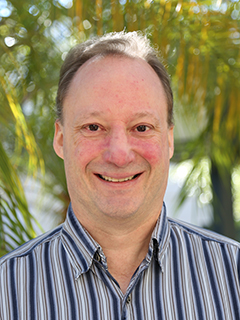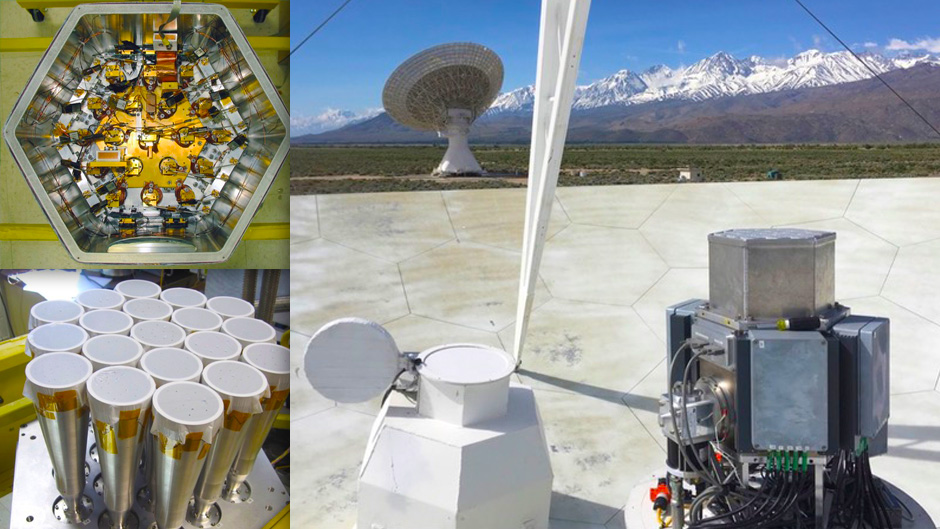No bigger than a microwave oven, a device designed and built by a University of Miami astrophysicist is helping an international team of astronomers obtain a colossal amount of data on how the universe’s so-called dark ages came to an end roughly 400 million years after the Big Bang.
Josh Gundersen’s 125-pound cryostat, which he partially fabricated at the University’s Coral Gables Campus, cools the receiver array of a high-tech radio telescope to 15 degrees above absolute zero, ensuring that the dish will be able to pick up light emitted by galaxies billions of years ago.
The cryostat took Gundersen and College of Engineering student Hugo Medrano 18 months to design and engineers another six months to assemble, install, and calibrate at the California Institute of Technology’s (Caltech) Owens Valley Radio Observatory (OVRO). It is a critical component of the new CO Mapping Array Project, or COMAP, an initiative that is helping to solve the mystery of what caused the rapid rise in the production of stars in the early universe.
Spearheaded by Caltech, COMAP investigates the origin of structures in the early universe that led to the galaxies we observe today, including those that are faint or hidden by dust. Using a 10.4-meter Leighton radio dish, the project measures carbon monoxide (CO) emissions from about 11.5 billion light years away.

“CO is the second most abundant molecule in the universe, the first being molecular hydrogen,” said Gundersen, a professor of physics in the College of Arts and Sciences, whose research ranges from the Milky Way to the cosmos to the Big Bang. “But it turns out that molecular hydrogen is quite difficult to observe,” he said. “So, we use CO measurements as a proxy for measuring large accumulations of material. It is comparably easy to observe, and it traces cold, molecular material that acts as a reservoir for star formation in newly forming galaxies.
“In a very real sense,” Gundersen continued, “we use these observations to look back in time to an age when the universe was quite a bit simpler, when the first generation of stars was starting to shine and when galaxies were first starting to assemble.”
The process, Gundersen pointed out, is like looking at a Christmas tree at night illuminated by lights. The lights on the tree are like the direct and reprocessed starlight that the James Webb Space Telescope is so effective at seeing, while the dim, cool branches of the tree are like the molecular material COMAP has been designed to study. “Each is a complementary way to study the early universe,” he said.
“Most instruments might see the tip of an iceberg when looking at galaxies from this period,” said Kieran Cleary, COMAP’s principal investigator and associate director of OVRO. “But COMAP will see what lies underneath, hidden from view.”
With funding from the Keck Institute for Space Studies and the National Science Foundation, COMAP recently reported its first year of observations in seven scientific journals. While the project has not yet detected a carbon monoxide signal, early results demonstrate the study should yield a strong detection of CO emissions by the time the current survey ends in 2024-25, ultimately providing the most complete picture to date of the universe’s history of star formation, according to Gundersen.
And because of the project’s spectroscopic capabilities, it will provide that image in three-dimensional format “much like an MRI machine can take slices of your knee,” Gundersen said. “The real excitement behind this line-intensity mapping approach is that it opens a whole new avenue to studying the early universe, and we happen to be on the bleeding edge.”
Gundersen, who attended planetarium shows as a grade schooler and caught the “cosmology bug” in middle school when legendary astronomer Carl Sagan’s “Cosmos” television series was released and put into book format, will remain with the COMAP project until its conclusion and, perhaps, even longer.
“We’re in the process of writing proposals to expand our efforts by building additional pathfinder-like receiver systems as well as other receiver systems that can probe even further back in the universe,” he said. “Specifically, the proposed instruments should be able to probe the so-called epoch of reionization when the first stars turned on and ionized the mostly neutral material in the universe.”
Other institutions involved in the project include the Canadian Institute for Theoretical Astrophysics, the Jet Propulsion Laboratory, New York University, Princeton University, Stanford University, Université de Genève, University of Oslo, University of Manchester, and the University of Maryland.

